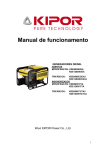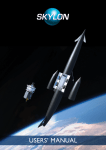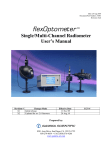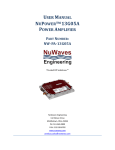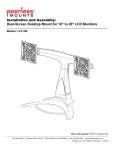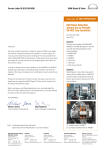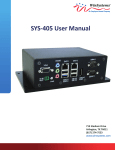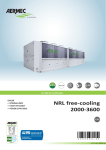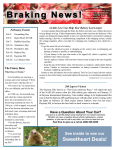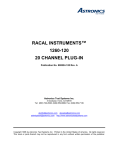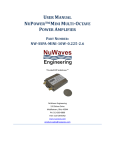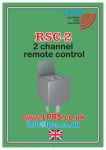Download Appendixes
Transcript
Appendix A Glossary of Field Abbreviations 591 Appendix A Glossary of Field Abbreviations Field Definition ComplLa weighing (complexity) factor in reliability allocation for La FIT failure rate in units of 10-9 FR failure rate L (λ) failure rate (measure of reliability) La allocated failure rate Lf field failure rate (imported from FRACAS) Lm manually entered failure rate Lp predicted (calculated) failure rate Ma maintenance action Mct maintenance corrective time MMH mean maintenance man-hours MTBCF mean time between critical failures MTBF mean time between failures MTTR mean time to repair NPRD non-electronic part reliability data PD power dissipation PTB product tree building R(t) reliability as a function of time 592 RAM Commander User’s Guide Field Definition RBD reliability block diagram RG reliability growth RP reliability prediction RP component data RP-related data influenced by the reliability prediction model (“Processor”) RTF RAM Commander file format, used for importing data from ASCII files S ambiguity factor (average number of iterations required to correct a fault) TAT turn-around time VSR voltage stress ratio Wm weighing (complexity) factor for maintainability allocation Xi probability of fault isolation to Ni replaceable items Appendix B Data Input Screens and Fields 593 Appendix B Tree Data Input Screens and Fields The numbers in the column “Dialog boxes with this field” on the next page refer to the table below: Dialog box name Number Tree Level Item Parameters 1 Tree General 2 Tree Operating (reliability) 3 Tree Nonoperating (reliability) 4 Tree Maintainability 5 Tree Miscellaneous 6 594 RAM Commander User’s Guide Tree Data Screens: fields and explanations Field name Description Dialog boxes with this field Values or field type Family Item family 2–4 --ELECTRONIC MECHANICAL EL-MECH. Item code Item code 2–4 See list of item codes on page 600 Ref. Des. Reference Designator 1–6 Part name Item part name 1–4 Quantity Quantity in current assembly 2–5 Environment Item environment 1, 3-4 See list of environment codes on page 603 Cur. ENV Current environment (set to parent’s environment if ––– in Environment field 1, 3-4 Set by RAM Commander Method of Lp If user defined, you must fill in the Method field 3–4 Default User defined Method Required if Method of Lp or Method of Mct are user defined 3–4 See list of prediction methods on page 601 (No prompt) Source for failure rate 3–4 Calculated User defined From FRACAS Allocated Appendix B Data Input Screens and Fields 595 Field name Description Dialog boxes with this field Values or field type (No prompt) Type of ambient temperature. If Fixed Temp, the item’s temperature is equal to the value entered in the adjacent °C field. If Delta Temp, the item’s temperature is equal to the value in the adjacent °C field plus the parent’s temperature. 1, 3–4 Fixed Temp Delta Temp o Temperature in oC 1, 3–4 Value in oC Cur. Temp. Actual current temperature 1, 3, 4 Set by RAM Commander FRp Predicted (calculated) failure rate 1, 3–4 Set by RAM Commander FRu User defined failure rate. Takes effect only if FR source is user defined (see above) 3–4 User defined floating point value Source of FRu Source of user defined failure rate 3–4 User defined string value FRf Failure rate from field data or from FRACAS. Takes effect only if FR source is FRACAS (see page 594) 3–4 Value of Lf FRa Allocated failure rate. Takes effect only if FR source is Allocated (see page 594) 1, 3–4 Value of allocated lambda Complexity for Complexity factor for reliability FRa allocation. This parameter is valid if you selected Allocated failure rate 3–4 Value of complexity factor Field factor 3–4 C Field factor multiplier for computing item failure rate 596 RAM Commander User’s Guide Field name Description Dialog boxes with this field Values or field type Duty cycle Duty cycle multiplier for computing item failure rate 3 Mult. factor Multiplicative factor multiplier for computing item failure rate 3–4 Add. factor Additive factor multiplier for computing item failure rate 3–4 Item Failure Computed failure rate value of current item 3–4 Set by RAM Commander Status Check Check status 3–5 Set by RAM Commander --- = no status Err = Error Warn = Warning O.K. = OK Status Calc Calculation status 3–5 Set by RAM Commander --- = no status Err = Error Warn = Warning O.K. = OK Catalog number Item catalog number 1–2 User defined string Military number Item military number 2 User defined string Generic name Item generic name used in library searches for component 2 User defined string Description Item description 1–2 User defined string Remark Item remark 2 User defined string Nc Number of on/off cycles per 1000 hrs 1, 4 Appendix B Data Input Screens and Fields 597 Field name Description Dialog boxes with this field Values or field type Cur. Nc Current number of on/off cycles per 1000 hrs (set to parent’s Nc if ––– in Nc field) 1, 4 Set by RAM Commander Method of Mct calculation If user defined, you must fill in the Method field 5 Default User defined (No prompt) Maintenance corrective time source flag 5 Calculated User defined Allocated Mct(c) Calculated maintenance corrective time calculated 5 Set by RAM Commander Mct(m) User defined maintenance corrective time 5 User defined floating point value Mct(a) Allocated maintenance corrective time 5 User defined floating point value Complexity for Complexity for allocated Mct Mct(a) 5 MLH(c) Calculated mean labour hour 5 Set by RAM Commander MLH(m) User defined mean labour hour 5 User defined floating point value False Alarm Rate False alarm rate 5 Level of replace Level of replace 5 Inapplicable Organizational Intermediate Depot 598 RAM Commander User’s Guide Field name Level of repair Description Level of repair Ambiguity factor Dialog boxes with this field Values or field type 1, 5 Inapplicable Organizational Intermediate Depot Discard 1, 5 Set by RAM Commander MTTRa Allocated MTTR 1, 5 User defined floating point value Conf. Level Confidence level 1, 5 70%, 75%,80%, 85%, 90%, 95%, 98%, 99%, 99.5%, 99.9% Mct [Hrs] Calculation result 5 Set by RAM Commander MLH Mean labour hours 1, 5 Set by RAM Commander MTTR Mean time to repair 1, 5 Set by RAM Commander Mct max Calculation result for a given confidence level 1, 5 Set by RAM Commander N1…N5 Fault isolation to N1…N5 parts with probability %1…%5 1, 5 User defined nonnegative integer %1…%5 Probability of fault isolation to N1…N5 parts 1, 5 User defined integer between 0– 100 Item price Item’s price in selected currency 6 User defined value Currency Currency code 6 $US FF Appendix B Data Input Screens and Fields 599 Field name Description Dialog boxes with this field Values or field type Item weight Item weight in kilograms 6 User defined floating point value Item volume Item volume 6 User defined floating point value Power consumption Power consumption in watts 6 User defined floating point value Current consumption Current consumption in Amperes 6 User defined floating point value Burn-in temperature in oC Burn-in o Temperature C 1, 6 User defined floating point value Burn-in Time Burn-in time in hours 1, 6 User defined positive integer PI FY Result from burn-in calculation. First year multiplier (ratio of the first year failure rate to the steady state failure rate). 6 Set by RAM Commander. 600 RAM Commander User’s Guide List of Item Codes (---) Assembly Laser Diode Breaker Laser Gas Bubble Memory Laser Solid Capacitor LF Diode Connection LF Transistor Connector Meter Crystal Miscellaneous Filter Optoelectronic Fuse Potentiometer HF Diode PWB HF Transistor Relay Hybrid Resistor IC Analog Rotating IC Digital SAW IC Memory Substrate Inductive Switch Lamp Tube Appendix C Methods and Environments 601 Appendix C Methods and Environments RAM Commander’s data base contains data from the following operating reliability prediction methods. This list is complete as of January 1, 1996. ALD will continue to update its data base support as new methods are issued. Operating Methods ALCATEL MIL-217E-1 P. stress BELLCORE Issue 5 MIL-217F-1 P. count BELLCORE Issue 6 MIL-217F-1 P. stress BRITISH TELECOM HRD4 MIL-217F-2 P. count BRITISH TELECOM HRD5 MIL-217F-2 P. stress CNET RDF93 rev 02/95 NPRD-95 GJB299 Part Count NSWC-92L01 Mechanics GJB299 Part Stress Siemens SN29500-1 HRD5 TELECOMM Table/Packed to Box ITALTEL IRPH93 Telcordia Issue 1 UTE C 80-810 602 RAM Commander User’s Guide Non-operating Methods MIL-217E-1 draft NPRD-95 RADC-TR-85-91 Table/Packed to Box Reliability Toolkit (1995) Maintainability Methods MIL-STD-472, Procedure 5 Method A Appendix C Methods and Environments 603 Defined Environments for Selected Operating Methods EnvironMIL 217E1 MIL 217FN1, ment FN2, Alcatel Bellcore Issue 5 Bellcore 6 Telcordia 1 British HRD5 Italtel Telecom IRPH93 HRD4 Telecomm CNET RDF 93 GJB299 RADC-TR-85-91 MIL-217E-1 draft AIA Airborne, Inhabited, Attack Airborne, Inhabited, Fighter Airborne, Inhabited, Attack AIB Airborne, Inhabited, Bomber Airborne, Inhabited, Cargo Airborne, Inhabited, Bomber AIC Airborne, Inhabited, Cargo Airborne, Inhabited, Cargo AIF Airborne, Inhabited, Fighter Airborne, Inhabited, Fighter AIT Airborne, Inhabited, Trainer Airborne, Inhabited, Cargo ARW Airborne, Rotary Winged Airborne, Rotary Winged Airborne, commercial (AC) Portable & Airborne, Airborne, Benign Inhabited, nonCargo stationary used, Temperature controlled Airborne, Airborne, Moderate Inhabited, Fighter Airborne, Inhabited, Cargo Airborne, Inhabited, Fighter Airborne, Inhabited, Trainer Ground, Mobile, Violence (GM2) Airborne, Rotary Winged 604 RAM Commander User’s Guide EnvironMIL 217E1 MIL 217FN1, ment FN2, Alcatel Bellcore Issue 5 Bellcore 6 Telcordia 1 British HRD5 Italtel Telecom IRPH93 HRD4 Telecomm CNET RDF 93 GJB299 RADC-TR-85-91 MIL-217E-1 draft AUA Airborne, Airborne, Uninhabited Uninhabited, Fighter , Attack Airborne, Uninhabited, Attack AUB Airborne, Airborne, Uninhabited Uninhabited, Cargo , Bomber Airborne, Uninhabited, Bomber AUC Airborne, Airborne, Uninhabited Uninhabited, Cargo , Cargo Airborne, Airborne, Airborne, Severe Uninhabited Uninhabited, Cargo , Cargo AUF Airborne, Airborne, Uninhabited Uninhabited, Fighter , Fighter Airborne, Airborne, Airborne, Extremely Uninhabited Uninhabited, Fighter Severe , Fighter AUT Airborne, Airborne, Uninhabited Uninhabited, Cargo , Trainer Airborne, Uninhabited, Trainer CL Cannon, Launch Cannon, Launch Cannon, Launch GB Ground, Benign Ground, Benign GF Ground, Fixed Ground, Fixed Ground, Fixed, Ground, Fixed, Controlled Ground, Fixed, Controlled Weather Ground, Weather protected Benign protected, Temperature controlled Ground, Non Non Fixed weather weather Uncontrolled Uncontrolled protected protected Ground, Fixed, Ground, Ground, Stationary, Benign Weatherprotected Ground, Stationary, Non Weatherprotected Ground, Fixed, Generic (GF1) Ground, Benign Ground, Fixed Methods and Environments 605 Appendix C EnvironMIL 217E1 MIL 217FN1, ment FN2, Alcatel Ground, Mobile Bellcore Issue 5 Ground, Mobile (both vehicular mounted and portable) Bellcore 6 Telcordia 1 British HRD5 Italtel Telecom IRPH93 HRD4 Telecomm Mobile Ground, Mobile (both vehicular mounted and portable) Ground, Ground Mobile vehicle installations, Protected CNET RDF 93 Ground, Non Stationary, Benign GJB299 Ground, Mobile, Smooth (GM1) RADC-TR-85-91 MIL-217E-1 draft Ground, Moign GM Ground, Mobile GMS Ground, Ground, Missile Silo Benign MFA Airbreathing Missile, Flight Missile, Flight Airbreathing Missile, Flight MFF Missile, Free Flight Missile, Flight Missile, Free Flight ML Missile, Launch Missile, Launch MP Manpack Ground, Mobile NH Naval, Hydrofoil Naval, Unsheltered Ground, Missile Silo Weather protected, Non temperature controlled Satellite, Launch Partly weather protected and non weather protected Missile, Launch Ground, Manually transport Non Stationary, Severe Naval, Sheltered, Generic (NS2) Missile, Launch Manpack Naval, Hydrofoil 606 RAM Commander User’s Guide EnvironMIL 217E1 MIL 217FN1, ment FN2, Alcatel NS Naval, Sheltered Naval, Sheltered NSB Naval, Submarine Naval, Sheltered NU Naval, Naval, Unsheltered Unsheltered NUU Naval, Naval, Unsheltered Undersea Unsheltered SF USL Space, Flight Space, Flight Undersea, Launch Missile, Launch Bellcore Issue 5 Bellcore 6 Telcordia 1 British HRD5 Italtel Telecom IRPH93 HRD4 Telecomm CNET RDF 93 Naval, Benign GJB299 Naval, Sheltered, Benign (NS1) RADC-TR-85-91 MIL-217E-1 draft Naval, Sheltered Submarines Naval, Submarine Naval, Ship environment Severe s, Non weather protected Spacebased, commercial (SC) Satellite, Flight Naval, Naval, Unsheltered Unsheltered Ground, Fixed, Atrocious weather (GF2) Naval, Undersea Unsheltered Space, Flight Space, Flight Undersea, Launch Appendix C Methods and Environments 607 Notes on Environments and Operating Methods BRITISH TELECOM HRD4 GB Ground, Benign: Nearly zero environmental stress with optimum conditions for operation and maintenance. Typical applications are in main exchange buildings, environmentally controlled remote exchanges or cabinets (including Case Repeater Equipment) and environmentally controlled subscribers’ premises. The equipment is operated in a protected environment, free from significant shock and vibration with the temperature of the air immediately surrounding the component not exceeding 55°C and relative humidity rarely exceeding 70% at 15°C. GF Ground, Fixed: Conditions less than ideal, with some environmental stress and limited maintenance. Typical applications are manholes, remote terminals and areas in subscribed premises subject to shock and vibration or temperature and atmospheric variations. GM Ground, Mobile: Conditions more severe than for Ground, fixed, mostly for shock and vibration. There is less maintenance attention and equipment is susceptible to operator abuse. Typical applications are mobile telephones, portable operating equipment and test equipment. Bellcore Issue 5 GB Ground, Fixed: Nearly zero environmental stress with optimum engineering operation and maintenance. Typical applications are central office, environmentally controlled vaults, environmentally controlled remote shelters, and environmentally controlled customer premise areas. GF Ground, Fixed: Some environmental stress with limited maintenance. Typical applications are manholes, poles, remote terminals, customer premise areas subject to shock, vibration, temperature, or atmospheric variations. GM Ground, Mobile: Conditions more severe than GF, mostly for shock and vibration. More maintenance limited and susceptible to operator abuse. Typical applications are mobile telephones, portable operating equipment, and test equipment. 608 RAM Commander User’s Guide Bellcore Issue 6, Telcordia Issue 1 GB Ground, Fixed: Nearly zero environmental stress with optimum engineering operation and maintenance. Typical applications are central office, environmentally controlled vaults, environmentally controlled remote shelters, and environmentally controlled customer premise areas. GF Ground, Fixed: Some environmental stress with limited maintenance. Typical applications are manholes, poles, remote terminals, customer premise areas subject to shock, vibration, temperature, or atmospheric variations. GM Ground, Mobile: Conditions more severe than GF, mostly for shock and vibration. More maintenance limited and susceptible to operator abuse. Typical applications are portable and mobile telephones, portable operating equipment and test equipment. AIC Airborne, commercial: Conditions more severe than GF, mostly for pressure, temperature, shock and vibration. In addition, the application is more maintenance limited than for GF. Typical applications are in the passenger compartment of commercial aircraft. SF Spacebased, commercial: Low earth orbit. Conditions as for AIC, but with no maintenance. Typical applications are commercial communication satellites. GJB299 GB Normally weather, almost no mechanical stress, and readily accessible to maintenance, such as laboratory with temperature and humidity controlled or large ground station. GMS Typical conditions in ground silo in which. missiles and its assistant equipment are set. GF (GF1) Typical conditions in the inside of generic building or on permanent racks with good ventilation. With moderate strike and vibration. Such as environment in which permanent installation radar, communications facilities, TV and recorder etc. are installed. NUU (GF2) Ground conditions with poor protected facilities for weather and Underground conditions. Severe conditions related to high temperature, low temperature, difference in temperature, severe humidity, mildew, salt vapor and chemic gas, etc. GM (GM1) Equipment installed on vehicles which moved smoothly. With strike and vibration conditions, such as special vehicle running on highroad, carriage of train. Appendix C Methods and Environments 609 ARW (GM2) Equipment installed on tracked vehicles. With violent strike and vibration conditions related to violently moving. and with restricted control of ventilation, temperature and humidity. MP Equipment manually transported in field environment. With poor maintenance conditions. NSB Typical conditions in submarines. NS (GS1) Include sheltered or below deck conditions on surface ship which travel smoothly. Unserious exposed to salt vapor and water vapor. Such as air-conditioning cabin of large cargo ship traveling near coastal waters and ship traveling in freshwater. NH (GS2) Sheltered conditions without exposed to weather conditions, but often with violent strike and vibration. Include sheltered or below deck conditions on surface ship. NU Typical conditions in board of ship. Unprotected surface ship borne, often with violent strike and vibration, exposed to weather conditions and immersed in salt water. AIF Typical conditions in fighter which can be occupied by pilots. Without high temperature, high pressure, and violent strike and vibration. AUF Severe conditions of high temperature, high pressure, and violent strike and vibration, etc., such as equipment compartment and bomb bay in fuselage, tail, wing of fighter. AIC Typical conditions in cargo compartments which can be occupied by an aircrew. AUC Environmentally uncontrolled areas which cannot be inhabited by an aircrew during flight. SF Earth orbital. Approaches benign ground conditions. Vehicle neither under powered flight nor in atmospheric reentry, such as installing environment of electronic equipment in satellites. ML Severe conditions related to missile launch, solid rocket motor propulsion powered flight, space vehicle boost into orbit, and vehicle re-entry and landing by parachute, such as noise, vibration, strike, and other severe conditions. 610 RAM Commander User’s Guide Appendix D Component Import Formats The following tables list, by screen name, the various input fields used in import files. Tree General Field name Length Type Description TRrefdes 10 Text Reference designator TRdepth 2 Int Tree depth level in the Import file: The first line (i.e. top of the importing Sub tree) must always have a depth equal to 1. Note that the RAM Commander handles up to 10 tree levels (including project top). TRicode 4 S text Predefined shortcuts of Item codes: Family type is determined by the RAM Commander due to the Item code. Mechanical and Electro Mechanical item codes are moved to other families. Tree hierarchy items (assemblies) must have the 'UNDEF' item code. If not specified or not included set to UNDEF. TRqty 4 Int Quantity of item(s) TRgname 21 Text Generic name (Short library code) TRcatnum 31 Text Catalog Number (Factory ID): Library may be accessed through the Cross Reference option. TRmilnum 31 Text Military Number. Library may be accessed through the Cross Reference option. TRpN 31 Text Part name (Manufacture ID). Library may be accessed through the Cross Reference option. FindName 31 Text one of the four item's identifiers (Generic name or Catalog Number or Military Number or Part name). If one column (field) of an Import file includes two or more item's identifiers (e.g. Generic names and Military Numbers) then you should use this field type. Upon completing the RTF import procedure you must run the 'Load from library' option to retrieve imported data. TRdscr 41 Text Item description. TRrem 21 Text Item remark. TRManuf 10 Text Manufacturer’s name TRlcn 19 Text Logistics Control Number Appendix D Field name Length Type Component Import Formats 611 Description TRSPTTm 12 Float Spare Part Turnaround time TRSPCRat 12 Float Spare Part Condemnation Rate TRSPMinQ 4 Int Spare Part Minimal Qty TRSPMaxQ 4 Int Spare Part Maximal Qty TRSPSMR 9 Text SMR Ignore n Text Field that should be ignored. n=Number of chars to be ignored (equal to 1 by default). This field is used to ignore columns of text file and/or make blanks between fields. Max width 150 chars. Operating Data Field name Length Type Description Notes OPftemp 9 Float Fix temperature. If both 'Fix temperature' and 'Delta temperature' fields are defined then Fix temperature will be used. OPdtemp 9 Float Delta temperature. If both 'Fix temperature' and 'Delta temperature' fields are defined then Fix temperature will be used. OPenv 3 S text Environment. All acceptable ENV values are listed in Section 2 of this Appendix. OPmldscr 31 Text Manual LAMBADA (L) source description. OPlswitc h 2 S text Switch of Lup definition method OPlcal 9 Float L calculated. OPlman 9 Float L manually defined by user. OPlfra 9 Float L from FRACAS. OPlall 9 Float L allocated. OPdc 9 Float Duty cycle. OPkfld 9 Float Field factor. OPlcmpl 9 Float L allocation weight (complexity). The following values are acceptable: CA=L Calculated; MA=L manually defined by user; FR=L from FRACAS; AL L allocated. 612 RAM Commander User’s Guide Non-operating Data Field name Length Type Description Notes NOftemp 9 Float Fix temperature. If both 'Fix temperature' and 'Delta temperature' fields are defined then Fix temperature will be used. NOdtemp 9 Float Delta temperature. If both 'Fix temperature' and 'Delta temperature' fields are defined then Fix temperature will be used. NOenv 3 S text Environment. All acceptable ENV values are listed in Section 2 of this Appendix. NOmldscr 31 Text Manual L source description. NOlswitch 2 S text Switch of Lup definition method. NOlcal 9 Float L calculated. NOlman 9 Float L manually defined by user. NOlfra 9 Float L from FRACAS. NOlall 9 Float L allocated. NOnc 9 Float Number of cycles / 1000 Hours. NOkfld 9 Float Field factor. NOlcmpl 9 Float L allocation weight (complexity). The following values are acceptable: CA=L Calculated; MA=L manually defined by user; FR=L from FRACAS; AL=L allocated. Appendix D Component Import Formats 613 Maintainability Data Field name Length Type Description Notes MNlorpr 2 S text Level of repair. The following values are acceptable: UN=Unapplicable; OR=Organizational; IN =Intermediate; DE=Depot; DI=Discard (i.e. not reparable). MNlorpl 2 S text Level of replace. The following values are acceptable: UN=Unapplicable; OR=Organizational; IN=Intermediate; DE=Depot. MNmswitch 2 S text MCT & MMH source switch: CA MCT & MMH Calculated; MA MCT & MMH Manual; L MCT Allocated. MNmctcal 9 Float MCT Calculated. MNmctman 9 Float MCT manually defined by user. MNmctall 9 Float MCT Allocated. MNmmhcal 9 Float MMH Calculated. MNmmhman 9 Float MMH manually defined by user. MNmstcmpl 9 Float Maintainability allocation weight. Miscellaneous Data Field name Length Type Description MIcurency 3 S text Currency: USD US dollars; FF French Francs. MIprice 9 Float Item price. MIcur 9 Float Current consumption [A]. MIpwr 9 Float Power consumption [W]. MIweight 9 Float Weight [Kg]. MIvolume 9 Float Volume [M3]. 614 RAM Commander User’s Guide Stress Information Stress 150 chars Example of Stress data: TJC=5;VSR=0.4; Text Stress information. Appendix E Import File Abbreviations 615 Appendix E Import File Abbreviations The following abbreviations can be used for import file field values instead of their full nomenclature that appears on screen list boxes. Item Code Abbreviations Abbreviation Definition BUBM Bubble memory CAPC Capacitor CBRK Circuit breaker CIND Coil, inductive device CONR Connector and IC sockets CONT Connection FLTR Filter (can be tree hierarchy item) FUSE Fuse HFDI High frequency diode HFTR High frequency transistor HYBR Hybrid IC (tree hierarchy item ICAN IC Analog ICDI IC Digital ICME IC Memory LAMP Lamps incandescent 616 RAM Commander User’s Guide Abbreviation Definition LFDI Low frequency diode LFTR Low frequency transistor LGAS Laser gas LSEM Laser Semiconductor device LSOL Laser solid state METR Meter MISC Miscellaneous OPTE Optoelectronic device POTN Potentiometer PWBD Printed wiring board QCRY Quartz Crystal RELY Relay (can be tree hierarchy item) RESI Resistor ROTD Rotating device SACW Surface acoustic wave SUBS Substrate (tree hierarchy item) SWIT Switch TUBE Tube UNDF Undefined tree hierarchy item Appendix E Import File Abbreviations 617 Hierarchy Item Codes UNDF is used for hierarchy item or item that represents a purchased part with User (manually) defined failure rate. FLTR, RELY if they have no children, they are calculated as usual; if one of them has "children", it is considered to be an assembly and gets "children's" failure rates. Hybrid are defined as follows: HYBR, then SUBS on next lower level, and then components on the next lower level 618 RAM Commander User’s Guide Environment Codes Abbreviation Definition AIA Airborne, Inhabited, Attack AIB Airborne, Inhabited, Bomber AIC Airborne, Inhabited, Cargo AIF Airborne, Inhabited, Fighter AIT Airborne, Inhabited, Trainer ARW Airborne, Rotary, Winged AUA Airborne, UnInhabited, Attack AUB Airborne, UnInhabited, Bomber AUC Airborne, UnInhabited, Cargo AUF Airborne, UnInhabited, Fighter AUT Airborne, UnInhabited, Trainer CL Cannon, Launch GB Ground, Benign GF Ground, Fix GM Ground, Mobile GMS Ground, Missile Silos MFA Airbreathing, Missile, Flight MFF Missile, Free Flight ML Missile, Launch MP Manpack NH Naval, Hydrofoil Appendix E Abbreviation Definition NS Naval, Sheltered NSB Naval, Submarine NU Naval, UnSheltered NUU Naval, Undersea, UnSheltered SF Space, Flight USL Undersea, Launch Import File Abbreviations 619 620 RAM Commander User’s Guide Stress Codes Part I (IC memory - Hf transistor) Stress parameters IC IC IC Resismemory analog digital tor Potentiometer Capa- Switch citor TJC + + + PDI + + + + + PSR + + + + + + + + + + + + + VSR VAP + + + + VAA Relay Lf Lf Hf Hf Stress diode transistor diode transistor parameters + + + + TJC + + + + + PDI + + + + + PSR + + + + VSR + + + + VAP + VAA VGS + + + + + VGS VGA + + + + + VGA VDS + + VDS VDA + + VDA CSR + + + + + + + CSR CAP + + + + + + + CAP FRA + + FRA FRS + + FRS Stress parameters IC IC IC Resismemory analog digital tor Potentiometer Capa- Switch citor Relay Lf Lf Hf Hf Stress diode transistor diode transistor parameters Import File Abbreviations 621 Appendix E Part II (Optoelectronic - Breaker) Stress para- Optometers electronic Bubble memory Connector Indu ctive Fuse Laser Diode SAW Lamp Filter Breaker Stress parameters TJC + + + PDI + + + + PDI PSR + + + + PSR VSR + VAP + - TJC + + + + VSR + + + + VAP VAA VAA VGS + VGS VGA + VGA VDS VDS VDA VDA CSR + + + + + + + CSR CAP + + + + + + + CAP FRA FRA FRS FRS Stress para- Optometers electronic Bubble memory Connector Indu ctive Fuse Laser Diode SAW Lamp Filter Breaker Stress parameters 622 RAM Commander User’s Guide Stress Parameter Abbreviations Abbreviation Description CAP Applied current CSR Current stress ratio (CSR) PDI Power dissipation PSR Power stress ratio (PSR) TJC Delta temperature junction to case (ambient) VAA Applied voltage (alternative) VAP Applied voltage (direct) VDA Applied voltage drain source VDS Voltage stress ratio drain source (VSRds) VGA Applied voltage gate source VGS Voltage stress ratio gate source (VSRgs) VSR Voltage stress ratio (VSR) VRA Rated Voltage VGR Rated Voltage gate source VDR Rated Voltage drain source CRA Rated Current PRA Rated Power FRA Frequency Applied FRS Frequency SR Appendix F Library Import File Abbreviations 623 Appendix F Library Import File Abbreviations and Field Names • CAPC Capacitor • CIND Coil, inductive device • CONR Connector and IC sockets • FUSE Fuse • HFDI High frequency diode • HFTR High frequency transistor • ICAN IC Analog • ICDI IC Digital • ICME IC Memory • LFDI Low frequency diode • LFTR Low frequency transistor • OPTE Optoelectronic device • POTN Potentiometer • PWBD Printed wiring board • QCRY Quartz Crystal • RELY Relay (can be tree hierarchy item) • RESI Resistor • SWIT Switch • BUBM Bubble memory 624 RAM Commander User’s Guide • CBRK Circuit breaker • CONT Connection • FLTR Filter • HYBR Hybrid IC • LAMP Lamps incandescent • LGAS Laser gas • LSEM Laser Semiconductor device • LSOL Laser solid state • METR Meter • MISC Miscellaneous • ROTD Rotating device • SACW Surface acoustic wave • SUBS Substrate • TUBE Tube Appendix F Library Import File Abbreviations 625 Library Import File Field Names Field name Type ICME ICAN ICDI RESI POTN CAPC SWIT RELY CONR LFDI LFTR HFDI HFTR OPTE CIND PWBD QCRY FUSE Description TYPE S + + + TECH S + + + + + + + + + + + + + + + + Device type (style) + + PACK S + + + QUAL S + + + PINS N + + + # Pins BITS N + + # Bits + + + + + + + + + + + + + + + + + + Technology + Package + + + Quality level GATE N TRNS N # Gates TETA N + + + + + + + + Theta jc [°C /W] TMAX N + + + + + + + + T junction max °C PMAX N + + + + + + + + VMAX N + + + + + + + IMAX N APPL S RESS S + + RESI N + + CAPS + # Transistors + + + + + + + + + + Power-rated dissip. [W] Voltage rated [V] Current rated [A] + + + Application Suffix for resistance + Resistance S + Suffix for capacitance CAPI N + Capacitance HFTH S + HFTR Matching HFTM S + HFTR Metalization OPTL S + OPTE Logic exists OPTC N + # characters OPTH N + # channels 626 RAM Commander User’s Guide Field name Type ICME ICAN ICDI RESI POTN CAPC SWIT RELY CONR LFDI LFTR HFDI HFTR OPTE CIND PWBD QCRY FUSE Description CAPT S + ESBT S + EEPROM Subtype EECC S + EEPROM Error Cor. Code PRYR N + + + + + + + Max rated temperature Years of production MTYR N + + + Maturity year MNYR N + + + Manufacturin g year UTIL N + + + Utilization period VLMP S + VHSIC Manuf. process VLDA N + VHSIC Die Area [cm²] VLFS N + VHSIC Feature Size [micr] VLVR N + VHSIC Voltage Range [V] NETR N + # Resistors RESC S + RE & RER Characteristic POTR S + RR Construction POTR S + RP Construction POTT N + # Tap CAPC S + CAPC Construction CAPF S + CAPC Configuration LFDC S RES1 N + + Stress– Temper. 1 RES2 N + + Stress– Temper. 2 RET1 N + + Temper. 1 °C + LFDI Construction Appendix F Library Import File Abbreviations 627 Field name Type ICME ICAN ICDI RESI POTN CAPC SWIT RELY CONR LFDI LFTR HFDI HFTR OPTE CIND PWBD QCRY FUSE Description RET2 N + + + Temper. 2 °C SRSB S GSBT S FRAG S + Fragility ISTR S + Internal structure + SRAM Subtype + GAAS Subtype FCO S + + EVAL S + + Contact form NCON N + KEYS N + CINT S + # cont interrupteurs CINV S + # cont inverseurs PROT S + Protection type COUR S + Courant for CNET MATR S + Material CSZE S + Contact size SURF N + Surface WIDW S + Largeur domin de pistos LAYR N + # layers HOWV N + # holes by wave HOHN N + # holes by hand WIRE N + # wires RFEQ N + + + + + + Evaluation for CNET # active contacts # keys (touches) + + Frequency 628 RAM Commander User’s Guide Appendix G Reliability Growth Modeling RAM Commander’s reliability growth module is the Duane method as described in MILSTD-1635. In this model, the tested mean time between failure (MTBF) is proportional to Tα where T is the cumulative operating test time and α is the growth rate index. On a loglog plot, the growth regression line is linear with slope α. The cumulative mean time before failure (MTBFc) is normally measured during testing and then divided by (1 - α) to convert it to the current instantaneous mean time before failure MTBFi. MTBFi is then plotted parallel to the MTBFc at an offset of 1/(1 - α). The test time at which this line reaches the required MTBF is the expected duration of the reliability growth test. RAM Commander uses Bootstrap, a new statistical technology that enables the user to calculate accurate confidence intervals for the main parameters of the Duane model by obtaining a large number of samples. Details of this method have been published in the paper “Bootstrap Technology for RAM Analysis”, Z. Bluvband and L. Peshes, Proceedings of the Symposium on New Directions in Military Reliability, Availability and Maintainability (RAM) Analysis, Maryland, USA, 1993. Appendix G Reliability Growth Modeling 629 Derivation of Model Equations According to the Duane formulation: λΣ = F KH − α E where: λΣ cumulative failure rate H total test hours F failure during H hours K condition-dependent coefficient growth rate α The original mathematical model was expressed in terms of cumulative failure rate. However, since equipment reliability is generally expressed in terms of MTBF, the following expression is more frequently used: ⎛T ⎞ MTBFR = MTBFI ⎜ I ⎟ ⎝ ti ⎠ where: MTBFR required MTBF MTBFI initial MTBF ti time at which initial data point is plotted (preconditioning time) time at which the instantaneous MTBF of the equipment under test will reach the required MTBF Differentiating the equation with respect to time, we receive Ti λ( t ) = ∂F = (1 − α ) KH −α = (1 − α )λ Σ ∂H 630 RAM Commander User’s Guide Thus, the current instantaneous failure rate is (1 – α) times the cumulative failure. That is, the instantaneous MTBF is 1/(1 – α) times the cumulative MTBF. The instantaneous MTBF may be interpreted as the MTBF that the equipment under test would exhibit if we stopped the reliability growth and continued testing. Thus, on a logarithmic plot, instantaneous or current-status curves are straight lines displaced a fixed distance from the cumulative plot by a factor of (1 – α). The cumulative MTBF (MTBFc) is normally measured during testing and then converted to the instantaneous (or current) MTBF (MTBFi) by dividing by (1 – α), that is: MTBF c. MTBF = i 1− α Appendix H Maintainability Prediction Modeling 631 Appendix H Maintainability Prediction Modeling This appendix presents theoretical development for five maintainability modeling techniques: • Maintenance Corrective Time (Mct) • Mean time to repair (MTTR) • Ambiguity factor • Maximum Corrective Maintenance Time • Mean Maintenance Man-hours per Maintenance Action (MMH/MA) Maintenance Corrective Time The formula for computing Mct is Mctj = TPREPj + TISOj + TDISj + TR / Rj + TREASj + TCALj + TVERj + TSTj where: Mctj average maintenance corrective or repair time for the jth replaceable item TPREPj average preparation time for the jth replaceable item TISOj average fault isolation time for the jth replaceable item TDISj average disassembly time for the jth replaceable item TR/Rj average time to remove/replace (interchange) the jth replaceable item 632 RAM Commander User’s Guide TREASj average reassembly time for the jth replaceable item TCALj average calibration time for the jth replaceable item TVERj average verification time for the jth replaceable item TSTj average time of start-up for the jth replaceable item Mean Time to Repair The formula for computing MTTR is N ∑ λ j [TPREPj MTTR = j =1 + TISOj + S (TDISj + TR / Rj + TREASj + TCALj + TVERj ) + TSTj ] N ∑λ j j =1 where: N number of replaceable items on the next lower level of the product tree λj failure rate of the jth replaceable item S Ambiguity factor, as computed below Ambiguity Factor The ambiguity factor is the average number of iterations required to correct a fault, and is computed as S= where: Xi 1 100 K ∑ ( X i − X i −1) i =1 ( Ni + Ni −1 + 1) 2 probability of fault isolation to Ni replaceable items. X1% < X2% < X3% < X4% < 100%. 0 < Ni Number of items in the ith ambiguity group X0 = N0 = 0 Maintainability Prediction Modeling 633 Appendix H It is assumed that failure is isolated to an entire group of 0 < Ni < 99 (for i=1…5) parts. The probability that the fault will be isolated for N5 parts is X5 = 100%. You can use up to 5 groups (i.e., i≤ 5). The probability of the highest one must be equal to 100%. Furthermore, the inequality X1% < X2% < X3% < X4% < X5% must hold. Maximum Corrective Maintenance Time The Maximum Corrective Maintenance Time for the φ-th percentile Mctmax(φ) is the value of corrective maintenance time below which φ percent of all maintenance actions are expected to be completed. Mctmax (φ) = exp [log MTTR + φσ Mct] where: N σ Mct = N ∑ (log Mcti ) 2 − [(∑ i =1 i =1 log Mct i ) 2 / N ] N −1 Mean Maintenance Man-hours per Maintenance Action Component level K MMH / MA = ∑ MMHi = i =1 where: K ∑ i =1 MPT i i 634 RAM Commander User’s Guide MMHi Mean maintenance man-hours required for the ith maintenance task (preparation, fault isolation, disassembly, reassembly, etc.) Ti average time to perform the ith maintenance task (see Mct definition above) MPi Manpower required for the ith maintenance task K number of maintenance tasks required (preparation, fault isolation, disassembly, reassembly, etc.) Assembly Level N MMH AS = MA ∑ λ j [ MMH PREP + MMH ISO + S ( MMH D / R + MMH R/ Rj + MMH CALj + MMHVERj ) + MMH STj j =1 ] N ∑λ j j =1 where: MMHPREPj average preparation MMH MMHISOj average fault isolation MMH. MMHD/Rj average disassembly / reassembly MMH MMHR/Rj average MMH of remove / replace (Interchange) MMHCALj average calibration MMH. MMHVERj average verification MMH MMHSTj average start-up MMH N number of replaceable items on the next lower level of the product tree. λj failure rate of the jth replaceable item S ambiguity factor The value of the ambiguity factor S is used in calculating the MTTR for an assembly. Appendix H Maintainability Prediction Modeling 635 Maintainability Allocation Maintainability allocation for each ith child of the current item is computed according to the formula: ⎛ ⎞ L( soni ) * Qty ( soni ) ⎟ Mct ( soni ) = MTTRa (item) + WM ( son)⎜⎜ ⎟ ⎝ ∑ WM ( soni ) * L( soni ) * Qty ( soni ) ⎠ where: Mct(soni) allocated Mct of ith child WM weighing factor for maintainability allocation Qty quantity of identical lower level items L(soni) failure rate of ith child 636 RAM Commander User’s Guide Appendix I Reliability Block Diagram Computation Formulae One of the modeling scenarios that can be implemented in RAM Commander’s RBD module is K-out-of-N redundancy, with or without repair. Appendix I Reliability Block Diagrams and Computational Formulas 637 K-out-of-N Without Repair The formulas in the following table are used to compute MTTF and reliability for various redundant item loads and without item repair. Source Data Models Load of redundant MTTF items 100% 0% Reliability 1 ∑ λ i=0 K + i ⎛ N − K⎞ ( −1)i ⎜ ⎟ ⎝ i ⎠ − ( K +i) λ ⎛ N ⎞ N−K ( N − K + 1) ⎜ e ∑ ⎟ ⎝ K − 1⎠ i = 0 K +i N − K +1 λ K e−K λ 1 N−K 0 < ν ⋅ 100% ≤ 100% 1 N∑− K 1 λ i=0 K + ν i t0 (K λ t0 )i ∑ i! i=0 N−K ⎛ N − K⎞ ( −1) i ⎜ ⎟ N−K ⎝ i ⎠ − ( K +ν i ) λ i=0 e ∑ K +ν i ν N − K ( N − K )! i = 0 N−K ∏ ( K + ν i) t0 t0 638 RAM Commander User’s Guide K-out-of-N With Repair γ = λ MTTR = µ MTBF The formulas in the following table are used to compute MTBF and reliability for various redundant item loads with item repair. Source Data Load of Repair redundant items Calculations Models MTBF (exact value) Unrestricted 100% S ⎛ N⎞ i ∑ ⎜ ⎟γ 1 N − K i=0 ⎝ i ⎠ ∑ Nλ S=0 ⎛ N − 1⎞ S ⎜ ⎟γ ⎝ S ⎠ Restricted 100% 1 N−K S λ S=0 i=0 Unrestricted 0% Mission Reliability over time t0 (approximate value) S ⎛ N⎞ ⎧ i ∑⎜ ⎟ γ ⎪ N − K i = 0⎝ i ⎠ ⎪ exp − ⎨ Nλ t0 / ∑ S = 0 ⎛ N − 1⎞ S ⎪ ⎜ ⎟γ ⎪⎩ ⎝ S ⎠ ⎫ ⎪ ⎪ ⎬ ⎪ ⎪⎭ 1 ⎛ N − S + i⎞ i (i + 1)! ⎜ ⎟γ ⎝ i +1 ⎠ ⎧ ⎫ ⎪ ⎪ N−K S 1 ⎪ ⎪ exp − ⎨λ t 0 / ∑ ∑ ⎬ N − S + i S=0 i=0 ⎛ ⎞ i⎪ ⎪ (i + 1)! ⎜ ⎟γ ⎪⎩ ⎝ i + 1 ⎠ ⎪⎭ 1 N − K ⎛ N - K + 1⎞ i ! ∑ ⎜ ⎟ K λ i = 0 ⎝ i + 1 ⎠ ( Kγ ) i N − K ⎛ N − K + 1⎞ ⎧ i! ⎫ exp − ⎨Kλ t0 / ∑ ⎜ ⎟ ⎬ i + 1 ⎠ ( Kγ )i ⎭ i=0 ⎝ ⎩ ∑ ∑ Steady State Availability (approximate value) ⎛ N ⎞ N − K +1 1- ⎜ ⎟γ ⎝ N - K + 1⎠ N ⎛ ⎞ 1 − ( N − K + 1) ! ⎜ ⎟γ ⎝ N − K + 1⎠ 1− ( Kγ ) N − K +1 ( N − K + 1)! N − K +1 Appendix I Reliability Block Diagrams and Computational Formulas 639 K-out-of-N with Repair, Source Data Calculations Models Repair Load of redundant items MTBF (exact value) Restricted 0% 1 1 - (Kλ ) N - K +1 [1 + (N - K + 1) (1 - Kγ ) ⎧ ⎫ ( Kγ ) N − K (1 − K γ )2 Kλ t0 exp− ⎨ ⎬ N-K 2 Kλ (Kγ ) (1 - Kγ ) ⎪⎩1 − ( Kγ ) N − K +1[1 + ( N − K + 1)(1 − Kγ )] ⎪⎭ Unrestricted 0<ν⋅100% ≤ 100% 1 N−K λ s=0 ∑ s γi i=0 i! s! ∑ ∏ [K + ( N − K + 1 − r) ν ] i r =1 s +1 γ s ∏ [K + ( N − K + 1 − r) ν ] r =1 S Restricted 0<ν⋅100% ≤ 100% 1 N−K λ s=0 ∑ i ∑ γ ∏ [ K + ( N − K + 1 − r )ν ] i i=0 r =1 s +1 γ ∏ [ K + ( N − K + 1 − r )ν ] S r =1 Mission Reliability over time Steady State Availability t0 (approximate value) (approximate value) 1 − ( Kγ ) N − K +1 S γ i i ⎫ ⎧ N − K +1 s! ∑ ∏ [ K + ( N − K + 1 − r )ν ] ⎪ N − K +1 ⎪⎪ N−K ⎪ 1- γ i = 0 i ! r =1 ∏ [ K + ( N − K + 1 − r )ν ] exp − ⎨λ t 0 / ∑ ⎬ ( N − K + 1) ! r = 1 s +1 S S=0 ⎪ ⎪ γ ∏ [ K + N − K + 1 − r )ν ] r =1 ⎪⎭ ⎪⎩ S i i ⎧ ⎫ ∑ γ ∏ [ K + ( N − K + 1 − r )ν ] ⎪ N−K ⎪ r =1 i=0 exp − ⎨λ t 0 / ∑ ⎬ 1−γ S +1 S=0 ⎪ γ S ∏ [ K + ( N − K + 1 − r )ν ] ⎪ r =1 ⎩ ⎭ N − K +1 N − K +1 ∏ [ K + ( N − K + 1 − r )ν ] r =1 640 RAM Commander User’s Guide Appendix I Reliability Block Diagrams and Computational Formulas 641 Reliability Distributions The following table lists the probability distributions and associated reliability functions used in computing reliability. Distribution Reliability Function R(t) = 1 - F(t) Exponential e −λ Weibull e t −( at ) b ∞ Normal ∫ f (τ ) dτ t Log normal ∞ ∫ f (τ ) dτ Probability Density Function f(t) Parameters λ e −λ λ= t ba b t b −1 e − ( at ) b (t −µ ) − 2 1 e 2σ σ 2π 1 e − (log t − µ ) 2 2σ 2 1 >0 MTBF a > 0; b > 0 - ∞ < µ <∞; σ>0 - ∞ < µ <∞; t σ t 2π Erlang ⎡κ −1(λ t ) i ⎤ e − λt ⎢ ∑ ⎥ ⎣i=0 i ! ⎦ λκ t κ −1 e − λt (κ − 1)! λ > 0; Uniform b−t b−a 1 for a ≤ t ≤ b b−a 0≤a<b σ>0 κ - positive integer 642 RAM Commander User’s Guide




















































